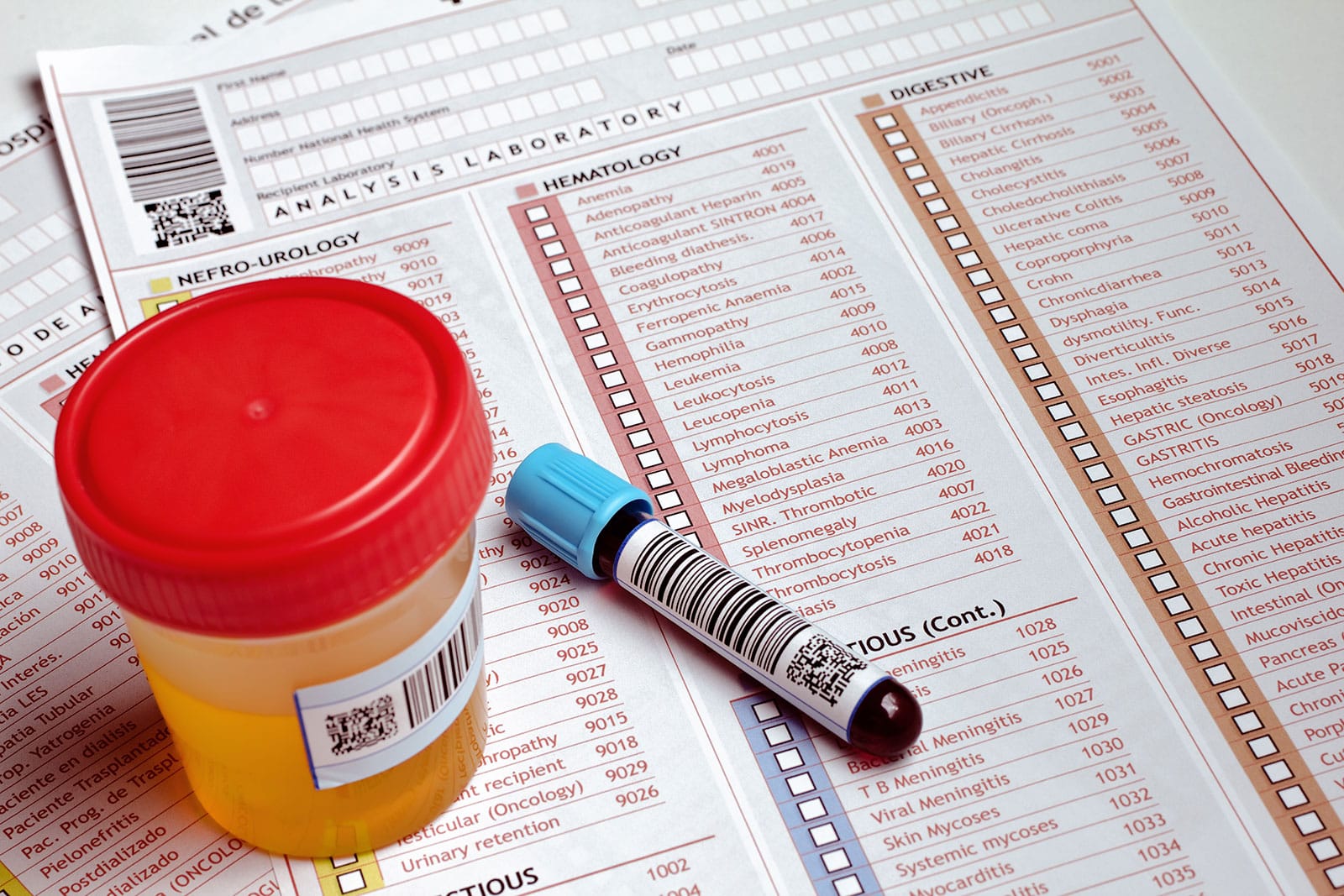If you’ve ever applied for a job or played sports, it’s possible that you’ve taken a drug test. And, in some professions, employees can occasionally be drug tested at random.
A drug test involves a chemical analysis of a person’s bodily fluid or hair follicles. Such a test can detect the presence of a certain substance or a group of substances. And one of the most common — if not the single most common — of these tests is the 5-panel drug test.
But why do people undergo drug tests? What societal role do these tests play? And what exactly is a 5-panel test?
Table of Contents
Applications of Drug Tests
Drug tests are simple to take. You just give a sample of your hair, urine, or sweat to a medical professional. (Most likely, you’d provide that sample in person — as opposed to bringing it with you — so that you couldn’t get it from someone else.)
Alternatively, the healthcare specialist might use a little needle to draw a small amount of blood from your arm. Either way, your sample would then go to a laboratory.
In our society, these tests have several major functions. For one thing, they let employees screen their job candidates and regularly check up on their staff members.
Of course, drug-free lifestyles are especially important for those responsible for others’ safety: healthcare professionals, firefighters, and airline pilots, to name just a few examples.
Unfortunately, when employees abuse drugs or alcohol, their work performance usually suffers. They might lose morale and become less productive. They may become more irritable and thus more likely to fight with supervisors, coworkers, and customers. They could experience more workplace accidents or miss work more often. And, if they’re desperate to procure more drugs, they might be tempted to steal from the company.
On top of all that, the court system sometimes drug tests defendants accused of committing crimes or causing accidents. And, in athletic leagues, drug tests can help ensure a fair playing field by identifying athletes who take performance-enhancing substances.
Also, when people undergo treatment programs for alcohol or drug use disorder, their care specialists may drug test them on occasion. That way, when patients experience relapses, they can receive the extra care they need.
What Is a 5-Panel Drug Test?
Drug test results typically come back on cards with one or more panels. For example, such a card could have four, seven, or 10 panels. Each panel pertains to a different substance.
In the U.S., the most commonly administered drug test is the 5-panel version. In fact, it’s used throughout the federal government. For instance, the Department of Transportation depends on this particular test to screen its job applicants.
In the private sector, the 5-panel drug test is widely recognized as the industry standard. In particular, employers frequently use it to conduct random drug testing.
Like most other drug tests, the 5-panel test usually examines urine. However, in some cases, blood, saliva, sweat, or hair samples are collected instead.
Substances Detected by the 5-Panel Drug Test
A 5-panel drug test looks for these substances: marijuana/cannabis, cocaine, opiates, phencyclidine, and amphetamines.
Keep in mind that the human body metabolizes and excretes different drugs at different rates. Thus, traces of a particular drug could linger for a few hours or a few days, or it could remain for a longer period.
In addition, different factors affect how fast someone can eliminate a certain drug. Those variables include the dosage size, that person’s height, weight, and tolerance for the substance, and how often that individual uses the drug.
Let’s take a look now at the drugs the 5-panel test can identify and how long those substances can remain in a person’s system.
Marijuana and Cannabis
These days, it’s legal in many places for people to use marijuana and cannabis products recreationally, without a prescription. Even so, it’s also legal for employers to forbid employees to consume these drugs. (The law also lets employers fire workers who don’t comply with marijuana and cannabis bans.)
The primary active ingredient in marijuana/cannabis is called tetrahydrocannabinol (THC). THC can remain in a person’s blood for up to 12 hours, saliva for up to 24 hours, and hair follicles for up to 90 days. And, in urine, this compound can linger anywhere from one day to one month. Occasionally, it lasts even longer than a month.
Cocaine
People snort or inhale cocaine for the fast and powerful high it gives them. Yes, this drug can definitely bring on a rush of energy and a sense of euphoria. However, cocaine is highly addictive, and overdoses can be very dangerous — even fatal.
In general, after someone takes cocaine, a drug test could spot it in saliva or blood for up to two days. Urine tests for cocaine, meanwhile, can come back positive for up to three days. However, if a person uses cocaine often, the drug can appear in urine for as long as two weeks. And, in a hair test, cocaine is identifiable months or even years after someone takes it.
Opiates
Opiates are compounds that derive from certain natural plants like poppies. (Opioids often get confused with opiates, but opioids are synthetic.) Heroin and morphine, for example, belong to the opiate group.
Opiates can relieve pain, induce euphoric feelings, and increase a person’s sense of well-being. Again, though, opiates are addictive, and opiate overdoses can lead to grave outcomes that include comas and death.
Urine tests can generally detect opiates for a maximum of three days. However, all traces of heroin may vanish from someone’s urine in just one day.
Phencyclidine (PCP)
Sometimes called angel dust, PCP is a powerful mind-altering drug that’s taken in powder or liquid form. Among other effects, it can give people a high, make them hallucinate, allow them to feel like they’re superhuman, and provide the sensation that they’re floating away from reality.
On the other hand, PCP can have severely negative consequences like memory loss, high blood pressure, depression, blurred vision, and fatal overdoses.
How long is PCP detectable? In urine, the answer is up to 14 days. In saliva, it’s as long as three days. And, in hair, it can once again be upwards of 90 days.
Amphetamines
Amphetamines are psychostimulants. That means these drugs speed up the messages that travel between the brain and the rest of the body. For that reason, prescription amphetamines can treat various medical disorders, including Parkinson’s disease.
When amphetamines are sold illegally on the street, they usually come in the form of tablets, powders, or crystals. And, while these drugs can make users feel happier and more energetic, they’re extremely hazardous. Amphetamine overdoses can lead to breathing problems, convulsions, strokes, heart attacks, and death.
A 5-panel drug test could identify amphetamine remnants in saliva for up to 60 hours, in blood for up to 48 hours, in urine for up to four days, and in hair for as long as 90 days.
Are you scheduled to take a 5-panel drug test soon? And are you worried about it because you’re struggling with a substance use disorder?
If so, we at Allure Detox Center in West Palm Beach can help. Our staff of experts provides effective and customized treatment programs. And our facility is safe, comfortable, and supportive. In short, we can help you rebuild your life, reclaim your future, and pass every drug test along the way. To learn more, please contact us at any time.
SOURCES
dhttps://adf.org.au/drug-facts/amphetamines/
https://americanaddictioncenters.org/pcp-abuse/effects-and-dangers
https://www.dea.gov/sites/default/files/2020-06/Morphine-2020.pdf
https://www.deadiversion.usdoj.gov/drug_chem_info/pcp.pdf
https://medlineplus.gov/ency/patientinstructions/000797.htm
https://my.clevelandclinic.org/health/diagnostics/10285-drug-testing
https://nida.nih.gov/publications/research-reports/cocaine/what-are-short-term-effects-cocaine-use
https://www.oregon.gov/adpc/pages/opiate-opioid.aspx


